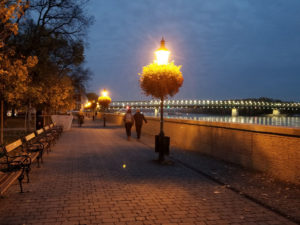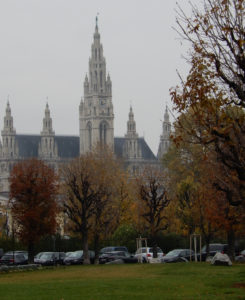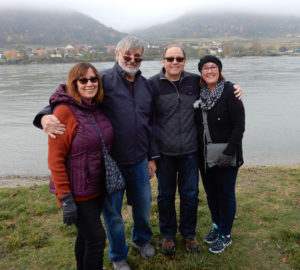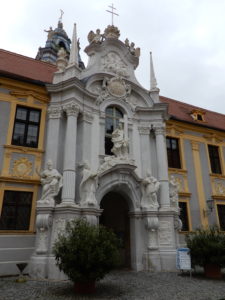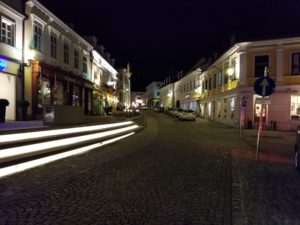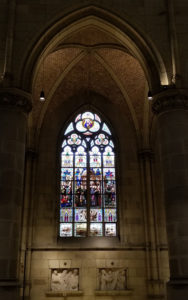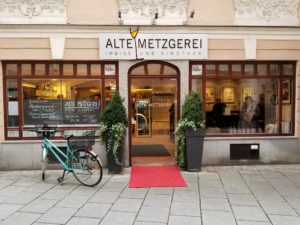Danube Viking River Cruise – Enchanted Wachau Valley and Central Europe
Our second Viking River Cruise was the result of a year of planning, anticipation and longing. After having our hearts stolen on the Rhine Getaway cruise, we knew we wanted to try another Viking River Cruise, so almost the minute we were back home, we got on the phone to book a Danube Waltz Viking River Cruise for the following year. The anticipation, longing and anxious waiting for our Danube Viking River Cruise adventure gave us the ability to press through routine days of work while thoughts of European adventure danced in our heads.
We choose a Viking River Cruise on the Danube because we had heard great things about this river from travelers we met on the Rhine cruise. Initially, we didn’t know much about the Danube and this itinerary didn’t sound that exciting to us, but the more research we did on the cities we would visit, the more interested we became. Now that the Danube Waltz Viking River Cruise is in the rear view mirror, we emphatically say it was a cruise experience we would not have wanted to miss.
To maximize the value of the long haul flights between California and Central Europe we added three days in Budapest before the cruise and seven days in Prague after. Viking River Cruise offers packaged itineraries that can be added before or after a cruise, however, we made our own arrangements for our stays on ground in Budapest and Prague. We have linked stories about these two captivating and seductive cities at the end of this story.
Day One – Budapest Hungary
After three days on our own romping around Budapest and discovering this world-class city and capital of Hungary, it was time to meet up with our ship to begin our cruise. Our Budapest hotel was just across the Danube from the Viking River Cruise dock. Transferring to the ship required the shortest of taxi rides and the friendly Viking crew made us feel immediately welcome as they took our luggage and directed us to the luncheon buffet that awaited us. One of the pleasures of a Viking River Cruise is that embarkation is much easier and faster than boarding a large ocean vessel. Our ship is the Viking River Cruise longship Vilhjalm.

Many of our fellow shipmates flew in arriving today, transferring directly from their flights to the ship. We knew from experience it would take them almost a full day to adjust and get rested. Many of them only made an appearance at dinner as they took advantage of the comfortable beds in their staterooms to crash and sleep.
TIP: This is why we recommend extending before the cruise to allow time to acclimate and adjust to the time zone. For most, the first 24 hours are shot.
While many of our shipmates sleep, we ventured back out onto the town.
Széchenyi Thermal Baths
Budapest is one of just two world capitals (Reykjavík Iceland is the other) that sit atop hot springs. Amazingly, Budapest has 125 thermal springs that produce an incredible 18 million gallons of thermal water each day with temperatures up to 172 degrees. These mineral-rich hot springs, purported to have medicinal properties, flow into the more than 15 public thermal baths around Budapest. Needless to say, these public baths are very popular with locals and visitors.

We were excited to take the waters and spent a day splashing and relaxing at the famous Széchenyi Thermal Baths in Pest. Pictured above is one of three large outdoor pools. Széchenyi is one of the largest bath complexes in Europe with 21 pools. On the sunny November day we visited, the outdoor temperature was in the low 40s and the outdoor pool was a pleasant 95 degrees, making the experience of submerging into the steamy mineral waters magical. Hanging out in the water, soaking up the healing powers, and people watching made for a wonderfully enjoyable experience. The only sadness came when we had to exit the water and feel the cold air on our bodies. The entrance fee is reasonable and lockers, towels and swimsuits are available for rental.
Day Two – Budapest Hungary
By this morning, most cruisers have caught up on sleep and begin starting the day with the shipboard routine of a tasty and hearty breakfast. After breakfast a shipwide announcement alerts us to grab our audiovox sets and meet on the shore for a tour of Budapest.
The audiovox is a small amplification device on a lanyard with a single ear bud that allows the tour guide to speak quietly and be heard by a large group. Ideal for crowded situations when multiple tour groups are in the same vicinity as the tour guides do not need to shout to be heard. Makes for a much pleasanter experience. We also found the devices allow us to linger or stray from the group a short distance while we continue to hear the guide’s tour presentation. As soon as the sound starts breaking up and getting static-y we know it’s time to look around and catch up with the group.
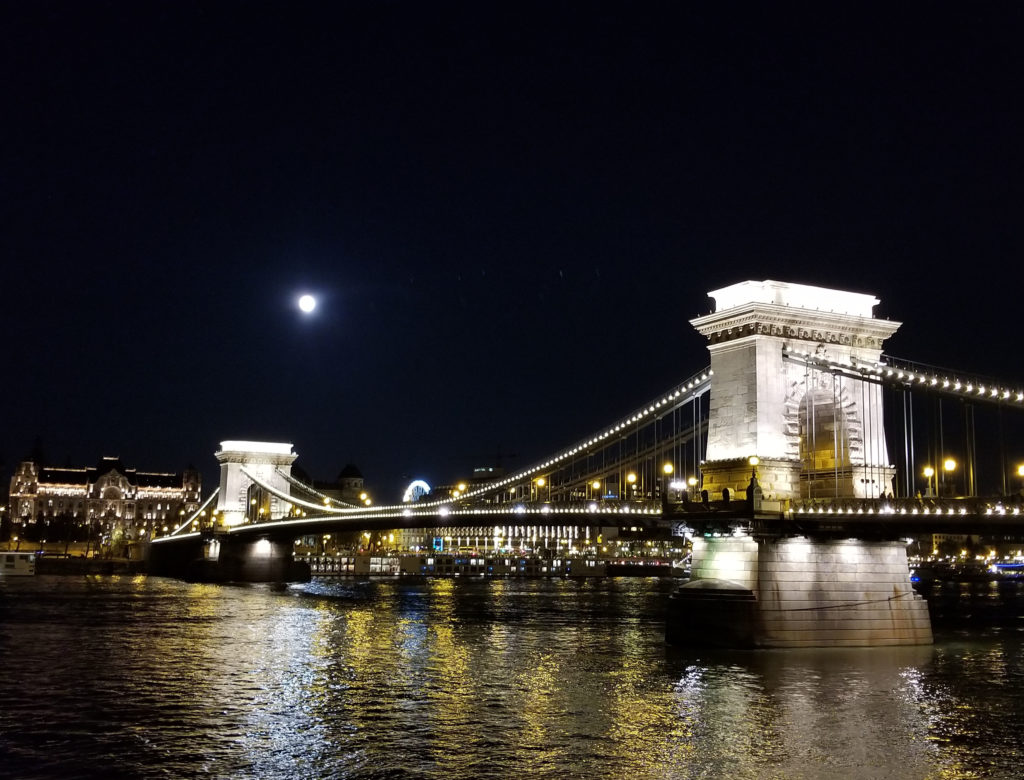
After a bus tour around the city highlighting the many sites and significant landmarks, the tour guide provided an overview of Budapest covering how it was settled by the Magyar tribes traveling from Asia, the Hapsburg’s rule, the numerous conflicts including WWII and the subsequent Communist occupation and rule. Ultimately, Budapest emerged as a parliamentary republic similar to Germany after USSR communist occupation.
FUN FACTS – We were surprised to learn:
- Budapest is the second fastest developing urban economy in Europe
- One of the largest cities in the European Union
- Considered one of the most beautiful cities in Europe, and
- Condé Naste ranked it as one of the world’s best cities.
Buda Castle and Hill
We visited Buda castle during our independent touring of Budapest before the cruise began — we discuss this in detail in our Budapest story (link at the bottom of the story). However, the Viking tour took us to another part of Buda Hill and Castle which to our surprise we completely missed during our independent visit. Moral of the story: Viking River Cruise included tours are really good, very comprehensive and not to be missed! Buda Hill is a long narrow hilltop anchored by Buda Castle at one end and Matthias Church, Fisherman’s Bastion and a small village and shopping district at the other end. We were very glad to have a second chance to see the sights we nearly missed.
Matthias Church
A short walk through the charming little village, we passed homes, shops and restaurants before the street opens to a large square dominated by the Matthias Church. On the far edge of the square Fisherman’s Bastion protectively separates the Matthias Church from Pest and the Danube.

Step inside the delicate sugar-frosted exterior of the 900-year-old church and you are confronted with the richly decorated interior featuring beautiful and extraordinarily detailed golden frescos. On a clear day, at just the right time, sunlight dances through the stained glass windows creating quite a heavenly feel.
Fisherman’s Bastion
Fisherman’s Bastion has seven towers representing each of the seven Magyar tribes that settled in the Carpathian Basin in 895AD. On the terrace of Fisherman’s Bastion is an overlook of Pest across the Danube. In medieval times the fishermen guarded this wall of the castle. When Fisherman’s Bastion was built-in 1895 it was named to honor these fishermen. A statue of King Saint Stephen I astride his majestic horse is featured in the center of the terrace.
TIP: There is a cafe tucked away behind King Saint Stephen I’s statue that has spectacular views. Definitely worth a stop for a coffee and to take in the panorama of the area.
Farewell Sail-Off
Back on board the Vilhjalm, the evening begins with a complementary cocktail hour that includes live music. Our Captain and Hotel Manager lead a toast to all of the guests and set an auspicious beginning to the adventures we are excitedly anticipating during the coming week. As we relax and enjoy our dinner, the food and service is excellent and the lights are dimmed a little. The ship casts off and begins a loop up and down the Danube so the entire ship may enjoy the breathtaking sights of Budapest lit up at night. And it is spectacular! The waterfront and buildings are fully lit and on display like a storybook city. Our favorite is the Hungarian Parliament building. Altogether, an exciting and special start to our Viking River Cruise.

Day Three – Bratislava Slovakia
Morning: Safety, Locks, Captain for a Day
We get a slow and lazy start to this sunny morning en route to Bratislava, Slovakia. After breakfast everyone participated in the mandatory safety briefing that includes mustering at our assigned emergency stations with our life vests donned. Our emergency station happened to be by the lounge. Cheers to safety.
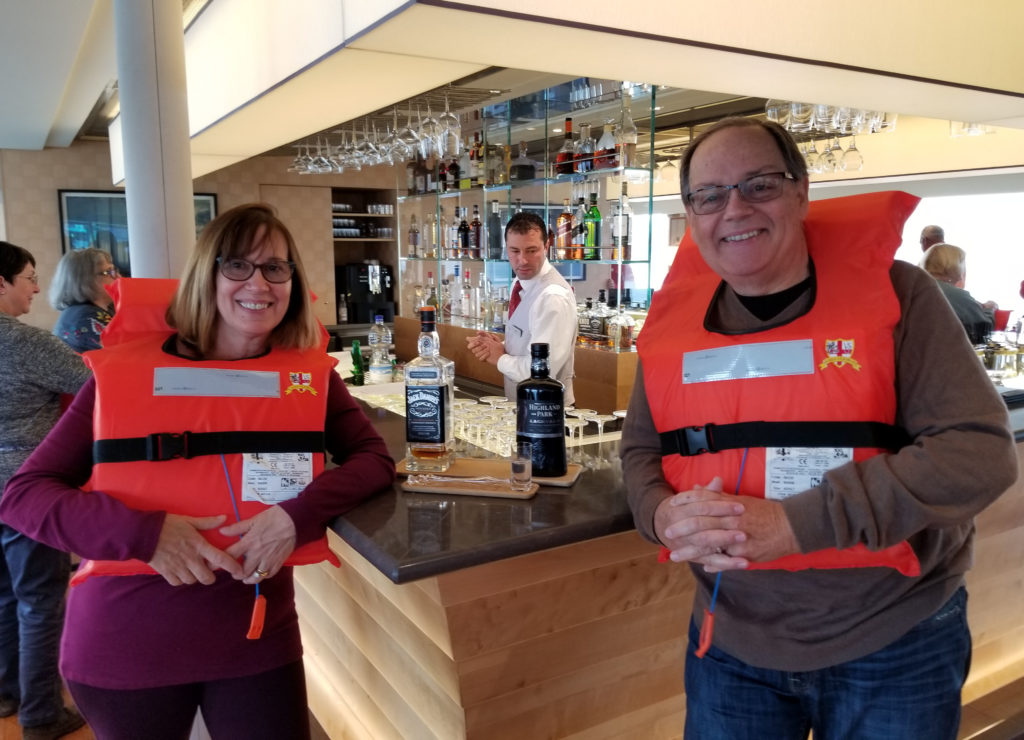
The morning continued with going through the Gabcikovo Locks And Canal. Since a lot of river cruising takes place overnight, most of the passages through locks occur after dark, however, we went through this lock during the daytime so we got an excellent view of how the locks work. The Gabcikovo Locks were impressive given the 59 foot height difference we rose.
The morning wrapped up with a tour of the bridge during which I connected with our Captain who explained the navigation of a Viking longship. We also talked a lot about the fun, and not so fun aspects of being a river boat captain. One particular part of the conversation I enjoyed was learning the career route to becoming a qualified ship’s captain which was very interesting and will be a topic for another story. Captain Marian Sulak was a very gracious host on his bridge and passionate about running a tight ship and caring for his guests.

Bratislava Castle and Old Town
We arrived in Bratislava after lunch and boarded buses heading off to the Bratislava Castle and seat of government for Slovakia. The drive to the castle took us through an exclusive residential neighborhood with many large estates many of which are homes to foreign embassies and ambassadors. Arriving at the castle there was a large plaza inside the walls offering sweeping views of the entire region and the city below. In the center of the plaza was an impressive bronze monument statue honoring Svätopluk I, also known as Svätopluk the Great, a ruler of Great Moravia. He ruled between 870–871 and again between 871–894 with a short period of imprisonment in the middle during 871.

After a short stop at the castle we head into the old town for a walking tour and some free time to explore on our own. This area was originally settled during the Neolithic period around 5,000 BC. A fortified town sprung up around 200 BC when a Celtic tribe settled in the area. Between the 1st and 4th centuries the area fell under Roman Empire rule. Typical of very old European towns were the narrow and windy cobblestone lanes lined with interesting shops and restaurants. The short lines of sight formed by the windy streets drew us into anticipating what was around the next bend.
Whimsical Street Art
Bratislava is known for street art and somewhat ironic life-sized bronze sculptures. These statues add a whimsical and modern touch to old town Bratislava. I was able to capture Barbara snapping a picture of a people-watching sewer worker peeking out from a manhole cover.
Following the guided tour, we were set free to spend time on our own. There was a pretty dancing fountain in front of the Carlton Hotel and Casino which made a great photo backdrop. We also discovered a quaint cafe and bar for a hot chocolate to warm our bones. At this point the sun was setting and we began the walk back to the ship.

Bratislava Waterfront Promenade
The town has a charming feel both during the day and as the sun retreats and the golden lights come up for the evening. One magical moment was the walk back to our ship. Leaving the Old Town the streets open onto a wide river promenade fronting the Danube. Dusk was falling and the lights were coming up, it was a spectacularly romantic looking scene and we were almost the only people enjoying it. In contrast to this dreamy scene we came across a most dramatic looking bronze statue of a Bulgarian freedom fighter wearing an eye patch, holding an automatic weapon in one hand and a fallen brother in the other hand.
From where our ship is docked, there is a striking view of the UFO Observation Platform and bridge just ahead on the Danube River. Atop the bridge is a restaurant and bar which features a nightly laser light show.

Day Four – Vienna Austria
We arrived in Vienna in the morning. It was a very grey and overcast day, but to our surprise, Vienna is our first taste of a major city with a skyline. Vienna is both a very modern city and an ancient city. Originally the Celts settled in this area around 500BC and Vienna has been continuously inhabited ever since. Today the city boasts nearly 1.8 million residents.
Interesting Fact – Vienna’s population has consistently been approximately 1.8 million people for over 100 years since 1900.

Today we decided to abandon the planned Viking tour and arrange our own exploration of Vienna. In part, this was because we wanted to really go deep at the Spanish Riding School. While there were tours for this, they were more skimming the surface. So we purchased tickets to the morning exercise program which is a 2 hour program. But first, we arranged for a taxi to the Hofburg Palace, a large sprawling complex in the heart of the city.

Hofburg Palace was built in the 13th century and served as the seat of the Habsburg Dynasty that ruled much of Europe for six centuries and the Holy Roman Empire from 1438 to 1740. Housed within the Palace complex are the royal apartments, the royal treasury, museums, a silver collection, the Spanish Riding School and much more. Pictured below is a wing of the Palace (left) now housing a museum, and the nearby Rathaus or city hall built in 1872 with the distinctive neo-gothic spires.
Spanish Riding School
We arrived at the Spanish Riding School, home of the famed Lipizzaner Stallions. Initially we didn’t know what to expect, thinking riding school and horses conjured up images of barns, corrals and hay. That image was far removed from reality. During the two-hour exercise session four horses at a time practice a variety of steps, movements and jumps accompanied by Viennese music in the elegant arena pictured below. No photography is permitted during the morning exercises.

For the past 450 years, the Spanish Riding School has practiced, and arguably perfected the study of how the Lipizzaner stallions naturally move. The goal is to cultivate the highest levels of Haute Ecole elegance the horse is capable of through systematic training. This creates a harmony between the rider and horse.
The Imperial Treasury – Hofburg Palace
On display at the Hofburg Palace is the Imperial Treasury. The treasury exhibit is divided into two sections, secular and ecclesiastical. Walking through the treasury, which is really more of a cross between a museum, jewelry store and church, is like a stroll through history. The artifacts are displayed chronologically from period to period allowing the viewer to see the transitions from one ruling dynasty to the next.
As we considered each piece, it became easy to imagine the people, their lives and the periods moving from the middle ages through the present. The collection contains both the Holy Roman Empire’s Imperial Regalia and the Austrian Crown Jewels (above), clothing, vestments, and religious artifacts. Included in the collection is the world’s largest emerald, a narwahl tooth thought to be a unicorn’s horn, and an agate bowl considered to be the holy grail. Yes, THAT holy grail. While we didn’t see any Knights Templar, Indiana Jones or Sean Connery during our visit, we do believe we chose wisely by visiting the Imperial Treasury. The collection is very large and easily requires a couple of hours minimum to view.
Leopold Museum
Leaving Hofburg Palace and crossing the main boulevard we entered Maria-Theresien Platz, a large plaza with monuments and greenery. The Platz is the anchor and centerpiece of the museumsquartier campus made up of several different museums. We were treated to a VIP photo opportunity when we arrived. Pictured is a portrait of Emmi Frisch, 1908 by the painter Ernst Ludwig Kirchner that I was drawn to. Somehow the artist captured something in the subject that created a familiar feel to me. It is hard to describe but I had the feeling as if I knew her.
We wanted to visit the Leopold Museum as it houses one of the largest collections of modern Austrian art. We were very interested to see the Gustav Klimt exhibition. Klimt known by many as the artist who painted the Lady in Gold featured in the 2015 movie starring Helen Mirren.
Vienna IS Art
Vienna is such a beautiful city with breathtaking architecture that it doesn’t come as a surprise to us that the Leopold Museum has “framed” the city by installing a picture window in a gallery featuring the Vienna skyline as art.

Day Five – Dürnstein, Wachau Valley and Melk Austria
Today will prove to be an interesting day as we will have a mixture of activities. A typical river cruise day arrives in a new destination in the morning and departs in the evening. However today we have three different activities. The morning will find us in Dürnstein, the middle of the day we’ll cruise the Wachau Valley and the afternoon and early evening will find us in Melk. By day 5 it sounds like a little more activity that we’re up for, but the change of pace is welcomed.
Dürnstein
As we eat breakfast the ship’s crew is tying us to the dock. Looking out from the dining room all we can see is levee. Maybe Dürnstein isn’t a town but just a stop on the river? But no, as we walk ashore, we learn the town is about a quarter of a mile down the levee path. This makes for a nice stroll along the waterfront as we follow a quaint path probably very similar to the one earlier travelers experienced in the mid-1100’s when the town was founded.
Dürnstein is a picturesque setting of a small town surrounded be vineyards and protected from above by a castle. Around 1192, Richard the Lion-hearted was imprisoned in Dürnstein castle by Leopold V, Duke of Austria following a dispute during the Third Crusades.
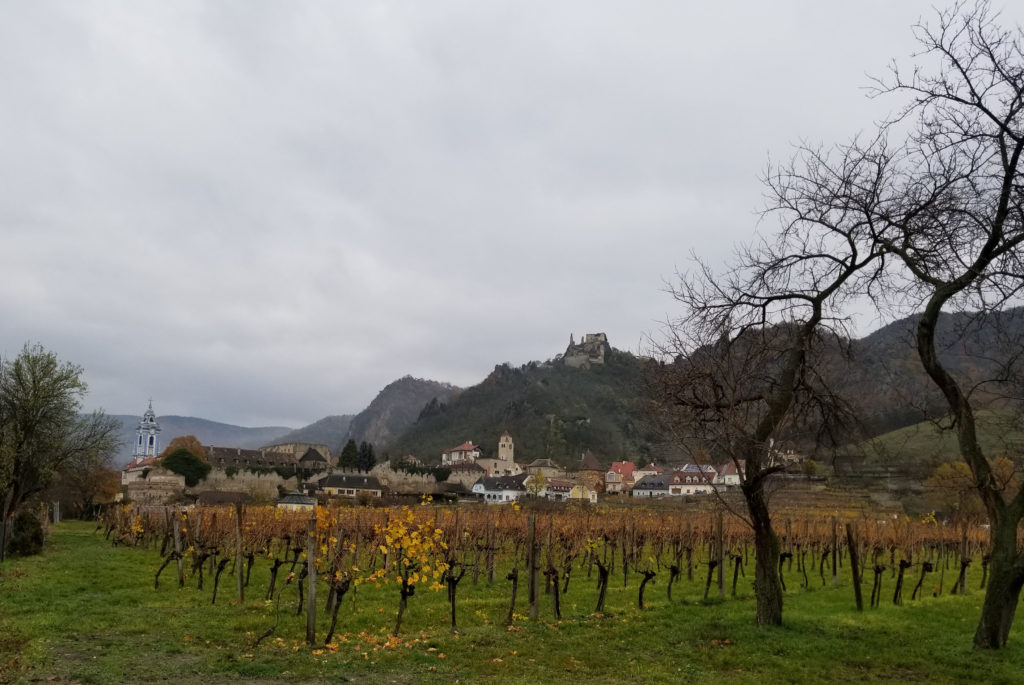
The town and church are walled for protection with the Dürnstein castle sitting high on the hill overlooking the town. Today, the town has 869 residents and does a thriving business in both wine making and tourism.

Dürnstein’s main street is lined with little shops catering to tourists. Many sell the award-winning wines grown in the region, but there are also bakeries, gift shops, restaurants, a hotel, post office and monastery. The croissants were delicious.

Medieval Walled City and Monastery
Interestingly, within the town’s walls exists the entire medieval town not much changed from the way it was in the middle ages. We felt as though we gained some insight and understanding of what life might have been like in a small town during the 1100s and 1200s. Pictured above is one of the entrances to the town. In medieval times, large guarded wooden doors were in place to prevent unwanted visitors.
The town also has a monastery and church identified by the blue steeple. The entrance courtyard is very private and features a baroque style facade. The monastery was founded originally as a chapel in 1372 within the walls of Elizabeth von Kuenring’s castle.
Wachau Valley
Leaving Dürnstein we travel deeper into the Wachau Valley. This is the Austrian region bordering the Danube River west of Vienna. Wachau Valley is known for rolling hills, vineyards and fortresses. The shoreline is dotted by many small villages and settlements with vineyards and wineries climbing the hillsides of this famous wine-producing region.

Cruising the Wachau Valley
In the early afternoon the slow meandering cruise of the Wachau Valley continues. There couldn’t be anything nicer than enjoying the rural scenery on a chilly day while enjoying a freshly baked chocolate chip cookie and hot chocolate in the Vilhjalm lounge.

Just as we become so relaxed we would like to gently cruise up this beautiful valley indefinitely, we arrive at the town of Melk.
Melk Abbey (Stift Melk)
We board buses for the ride to a Melk Abbey situated on a rocky outcrop overlooking the Danube river in the town of Melk. Pictured below is the Abbey as we viewed it walking back to our ship in the evening. We learned as we traveled in Austria that many government and religious buildings customarily feature golden-colored facades. As the metal gold was valuable, it was believed that golden-colored buildings were valuable and prestigious.

Surrounding the Prelate’s or main courtyard of the Abbey were four whimsical frescoes. The figures pictured look very modern but actually are very, very old.

The three musketeers hamming it up for the camera in the Prelate courtyard. Derrick (left) is a good friend, Larry (right) is Barbara’s brother and Jon is in the middle.

The abbey was founded in 1089 when Leopold II bestowed upon the monks from Lambach Abbey one of his castles. The church within the Abbey is an impressive sanctuary adorned by beautiful and ornate rose and gold-colored frescos detailing the stories of the church.

The Abbey is recognized for its humongous collection of manuscripts and early writings. The total collection exceeds 100,000 volumes, 25,000 of which were published before the 18th century, and 750 editions that pre-date the 1500s. Pictured is one of twelve library rooms housing the Abbey’s collection and its beautifully painted ceiling. Out tour took us through this room, however the other eleven rooms are off-limits to visitors.

The Abbey is also known for operating a secondary school serving 900 co-ed students.
Town of Melk
Leaving the Abbey the town of Melk unfolds before us down a gentle hillside toward the Danube. While the majority of our shipmates took the short bus ride back to the ship, we opted to stay behind to see more of the charming town of Melk. We were advised returning to the ship on foot was a thirty minute walk through town and a “wooded” area.

Walking down the hill from the Abbey to the town, the sun set and it quickly became dark. We were again treated to a beautiful lit town enveloped in the peacefulness of the early evening. The town and buildings were perfectly lit to give a fairy tale feeling to the quaint town. We stepped into a cafe moving from the very cold air outside to the warmth and coziness of the small gathering spot, a favorite of locals. Our coffee arrived and was served as we had come to understand and expect as the Austrian way. Presented on a tray, with cream on the side, and a small glass of water with an upside-down spoon balanced on the rim. This became a fun and cherished memory of enjoying coffee versus the paper cup and plastic lid we were accustomed to back in the states.
After our coffee we strolled through the streets reaching the edge of town. We were treated to one last breathtakingly beautiful view of the Abbey, all washed in light sitting on the hill looking down on us (pictured above).
Lions, Tigers, Bears, and WEREWOLVES – Oh My !
Leaving the town and following the path back to the ship was quite an adventure. After crossing a major roadway, we followed the path which was a concrete walkway about 20 feet wide leading into the “wooded” area. To clarify for purposes of our story, wooded quickly became heavily forested – Think Little Red Riding Hood or Disney’s Beauty and the Beast. The lights along the path were a far distance apart. This caused every so often the light from one to begin to fade into darkness with the light from the next one able to be seen ahead, with an area of darkness between. As we proceed through the woods, the sky disappears giving way to a thicker and heavier tree canopy over our heads.
The conversation turns to a recognition of being in a foreign land far from home, walking through an unfamiliar forest, and clearly in an environment that we would never place ourselves in back in the states. Knowing if something happened to us our discovery would be major headlines. We wonder if it actually is (as we often hear) safer in Europe than in the US, or was walking back just not a smart idea.
Then we reassure ourselves that this option would never have been suggested to us if it were dangerous. Tour operators don’t make a habit out of losing their guests…do they? Then the gallows humor kicks in as we ask if the werewolves and other creatures inhabiting the woods got the memo not to eat the tourists. After 20 minutes of waking through the woods, the trees and bushes thin and we are suddenly in a clearing within sight of our ship. We survived. Little Red Riding Hood and Belle have nothing on us.
Taste of Austria
This evening at dinner we are treated to a ‘Taste of Austria’. Local musicians are roaming through the dining room playing traditional Austrian folk music. They even joined us at our table. We were treated to tasty traditional Austrian food. All of it was mouth-watering. A favorite is the gigantic home-made pretzels on the table, notice the last one in the picture below. It disappeared immediately after the picture was taken, however another batch soon appeared.

The Viking River Cruise ship’s crew dressed in traditional Austrian clothes to add a further element of style and authenticity to the dinner. Alex the dining room Maitre D’ (below) is wearing lederhosen as he ensures another excellent dinner. Our fellow travelers enjoyed a traditional customary feast of Austrian food with lots of meats and cheeses.
Since we are vegan, we were served a wonderful stuffed bell pepper the chef prepared especially for us. Many of our shipmates sitting nearby asked us about our special entrees and wondered why they didn’t get one. Alex the Maitre D’ and Jürgen the Executive Chef did a stellar job of accommodating our requests for vegan options and delivered an over-the-top experience throughout the entire cruise. There were many times during the week that our fellow shipmates were asking and longingly coveting our special vegan meals that we enjoyed.
Day Six – Linz Austria
Our ship is docked about two blocks off of this main square in Linz. We are treated to a tram ride around parts of the town near the river seeing the more modern city across the river and then returning to the Old Town. Linz is larger than many of our stops but still has a population of around only 190,000 putting it on the smallish town size. Note, the golden buildings — it really is a VERY popular color in Austria.

Largest Cathedral in Austria
Our first stop is The New Cathedral also known as the Cathedral of the Immaculate Conception built in 1862 in a Gothic Revival style. The Cathedral is Roman Catholic and the largest Cathedral in Austria, however, it is not the tallest. St. Stephen’s Cathedral in Vienna stands 448 feet tall beating The New Cathedral by five feet at only 443 feet. The sanctuary of the New Cathedral can hold 20,000 worshipers and is massive.

The New Cathedral is recognized for it beautiful stained glass. With a small confessional holding a priest in the middle and two congregants, one on each side, we could only image the time it could take to hear all of the confessions of 20,000 parishioners.
Much of the architecture in Linz is stylish and ornate. Inviting businesses dot the streets including the pictured Alte Metzgerei translated to ‘Old Butcher Shop’ snacks and wine bar. There was also a large vegetable and fruit market in an indoor mall.
In the Old Town while cars have access, it generally seems to be predominately a pedestrian area. The major thoroughfare has light rail trains running constantly with one passing what seems like every couple of minutes. Who needs a car?

Off of the Hauptplatz main square entering the Old Town there was an open air market with many food stands. Being vegan, we were drawn to photograph the delicious vegetable stand.
The Sound of Music Entertainment
This evenings entertainment provided before diner in the lounge is by three very talented local singers performing a collection of songs from the Sound of Music. In addition to the songs, there were sing-along favorites, and a banter of jokes and comedy blending in a little history and interesting facts about Austria. A good time was had by all, except our gathered shipmates in the lounge felt like little Gretl Von Trapp and were sad when the last song started – So long, farewell, Auf Weidersehen goodnight… We weren’t ready to say farewell and be sent away.
The mood quickly improved as we moved to the dining room for another delicious dinner.
Day Seven – Passau Germany
Day seven and our last full day on the cruise portion of our vacation. We arrive and dock in the little university town of Passau Germany and the fourth country we visited during the cruise. Across the river is a cute row of buildings lining the waterfront.

The Black Plague
The morning starts with a short walking tour giving us the flavor of the town. Our guide is a very gregarious and knowledgeable local who shared that she was raised in Chicago and relocated with her husband to Passau. She taught at the local university in Passau for many years and became a tour guide after retiring from academia. She peppered us with countless stories and trivia about early life from the 14th century on. One of these stories I found interesting was about the advent of the transom windows and how when the Black Plague outbreak occurred, food would be passed to the residents locked into their homes. The food was passed in through the transom windows using a paddle or peel on the end of a stick giving rise to the expression, ‘I wouldn’t touch them with a ten foot pole’.
Old Town Character
We saw many characters walking around the Old Town. Above is a happy fellow riding his delivery bike in the bohemian/artist quarter, and in a courtyard we were surprised to find a pop-up of mobile food (MoFo) carts. Each year the local artists use a different color scheme to paint the cobblestones (pictured below) creating a path for visitors leading through the town. On the Rathaus (city hall) is a fresco guarded by a stately statue of a proud lion. Inside the small windy streets of the tourist and shopping district were many sidewalk cafes and little shops inviting us in to browse.
As the day turns to evening, a light rain begins to fall. We’ve spent the day exploring the town and browsing in the shops and windows. For a small town, they had a lot of intriguing shops and we found a few items we had to have as memories of our trip. Now it’s time to make our way back to the ship for our final evening with new friends and enjoy our final celebration dinner and late evening in the lounge listening to music and dancing the night away.

Day Eight – Passau Germany
Our final cruise day is filled with hustle and bustle, farewells, sadness and excitement at the same time. This is the morning when the cruise ends and new friends and travel buddies head their separate ways. We also must leave the comfort and pleasure that has become very familiar over the past week. After breakfast, everybody shifts into the disembarkation routine and transfer to flights home, post-trip excursions with Viking, or, in our case, transferring to another week of post-cruise touring.
Prague Here We Come
Since we are spending an independent week in Prague, we scheduled a driver to meet us at the Viking dock in Passau and drive us to Prague. Our private car and driver arrives right on schedule for the three-hour drive from Passau Germany through the countryside to Prague, Czech Republic. We are excited to visit Prague which has been described to us as a true fairy tale city with a unique vibe and culture. We are also intrigued to visit this city that once was cut off from the west by the Iron Curtain but became independent in 1989 after peaceful demonstrations of it’s citizens in what is known as the Velvet Revolution. For more about Prague, and how to make private post-cruise arrangements, check out our Prague story link below. Happy Travels.
Like this? Share it on Pinterest. . .

More Danube Viking River Cruise Resources
Read about pre-cruise Budapest here.
Read about post-cruise Prague here.












